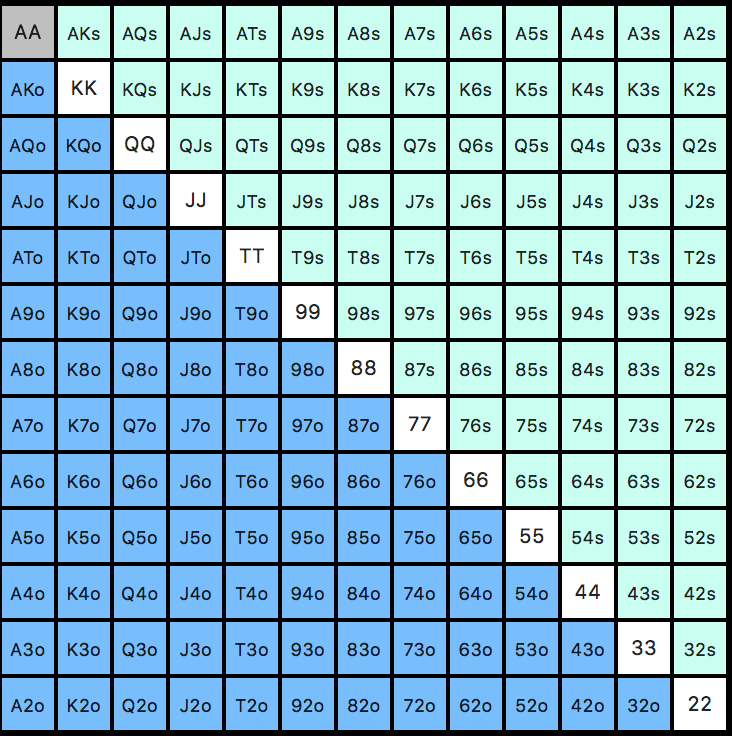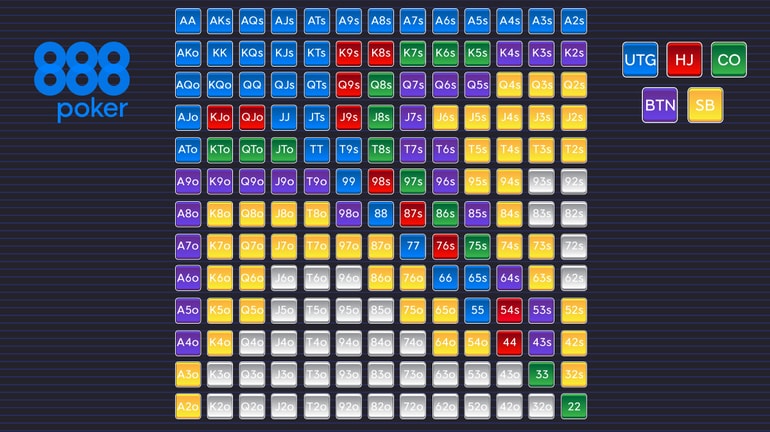
Online Poker » Poker Strategy » Texas Hold Em » Pre Flop Play


Preflop play in poker is generally the easiest stage of the game. You are dealt your hand and there are 3 decisions as to what to do with it - you can call, raise or fold. Simple enough, right.
Preflop Texas Holdem Strategy Your preflop poker strategy forms the foundation of your game. Your first decisions will be made preflop during a hand, so it is important to get these decisions right. Thankfully this is one of the easier areas of the game to understand. If we were to indicate the strength of a preflop holding very roughly, then typically the further up the grid you go, and the more you go to the left, the stronger the preflop holding will be. There are huge exceptions to this general rule, however, since we have seen that a hand at the bottom right of the grid (i.e. 22) can be stronger than a. Online Poker » Poker Strategy » Texas Hold Em » Pre Flop Play. Preflop play in poker is generally the easiest stage of the game. You are dealt your hand and there are 3 decisions as to what to. The hands you play preflop are the starting point of your game. A poor preflop strategy is like building a house on quicksand – you will go nowhere quickly. There is a very good reason engineers dig a deep hole when building skyscrapers – you need a solid foundation. The same applies to poker and preflop is the foundation of your game.
Well, hold on. Although preflop play is the simplest aspect of any poker game, it's not as easy as it sounds. There may only be 3 decisions to choose from, but if you don't have an understanding of basic poker fundamentals, the decision you make preflop can easily be a losing one.
The focus of this article will be on the fundamentals that you need to make the best decisions possible preflop. These fundamentals include position, hand ranges and how you should enter the pot.
Understanding Position
Position in poker is one of the most important fundamentals that you will ever learn. Understanding position will make your preflop decisions much easier and will often make life easier post flop as well.
Texas Holdem Preflop Odds

Ok, so what exactly is position? Position refers to where you are seated at the table in relation to the dealer button. The closer you are to the left of the dealer button, the earlier the position you are in. Being in early position means you will have to act first or act before most of the other players on subsequent rounds. Since you are one of the first to act, you will not be able to see what the other players do beforehand. This is a huge disadvantage because you don't know if those left to act behind you have a strong hand or not.
On the other hand, the closer you are to the right side of the dealer button, the later the position you are in. This will mean you get to act later on all betting rounds with the button being able to act very last. Being able to act last is an advantage simply because you get to watch all the other players act before you do and can make your decisions based on what you see.
Having an understanding of position is going to be important because it's going to often dictate what hands you choose to play in addition to how they're played.
Preflop Hand Ranges
Preflop hand ranges in a vacuum is a pretty easy concept to understand. The earlier the position you are in, the less information from your opponents you will obtain before you have to act. Because of this, you will want to play much stronger hands from early position to avoid being in marginal situations later on.
Preflop Poker Range Construction & Analysis [2020]
As you move around the table into later position, the range of hands you decide to play can widen since it will be more likely you'll have position on other players on subsequent rounds.
For example, at a six max cash game my under the gun ranges will consist of KQ suited or better, AT suited plus and all pocket pairs. From middle position, I will add other broadways such as KJ, KT and A9 suited. In later position, my hand ranges as a default will consist of all of my early and middle position hands as well as all of my aces, most suited kings, suited connectors and 1/2 gapers.
Now, with all of that said, it's important to realize that hand ranges such as the one I outlined above will change and can change drastically depending on the other players at the table, their tendencies and their position in relation to yours.
For example, if a tighter player opened the action in early position, I would fold most of my hands other than AK, AQ, and all of my pairs (in position). The reason being is that a tighter player from under the gun would have a tight hand range and I don't want to be playing hands that are likely behind.
On the hand, if it were a looser player who opened from early position, their hand range would be much wider. This would enable me to play a wider hand range myself, especially since I'll be in position and will act last on the other betting rounds.
If you were to switch the roles and assume you opened with KQ suited from under the gun per the range outlined above and the player on the button 3-bet you, this would be a spot where you might have to fold. The reason is that the player in later position would have to assume your opening hand range is going to be tight and despite that and the fact that you opened with a raise, he still felt his hand was better and re-raised you. Also, you would have to consider that you'll be out of position, which makes playing KQ much more difficult to play. Even if a looser player with a hand range that KQ surely beats 3-bet you, a fold from under the gun would still be good given your position in relation to theirs.
Ok, so these are two examples of the many scenarios you might find yourself in preflop. While there are too many to list individually, here is a basic guide to preflop hand ranges:
- The earlier the position you are in, the better the hands you want to play. You don't want to play marginal hands out of position because you'll have a difficult time knowing where you're at in the hand.
- The tighter the player who opens in front of you, the tighter you want to be when/if you call or raise. The looser the player, the wider your hand range can be.
- You can open a much wider range of hands when you are first to act and there are tighter players to act after you. They will have such a tight range that they'll be folding often. However, if there are looser players to act after you, you want to be tighter since they'll be calling you more often and forcing you to play more flops.
Cached
- Focus on playing hands in position than out of position. Being in position will enable you to play marginal hands and bluff/steal more effectively. Additionally, you will also want to control the pot size depending on your position. Playing a big pot in position is much easier than playing the smallest of pots out of position.
Entering the Pot Preflop
As a general rule of thumb, whenever you enter a pot you should be doing so with a raise. My only exception to this is in tournaments and sit n go's where I may opt to open limp preflop with small pocket pairs in the early stages.
There are several reasons for raising preflop as opposed to open limping. For one thing, you can end the hand preflop and take the blinds. Two, you take the initiative in the hand which enables you to be the postflop aggressor where you can more than likely c-bet and take the pot. Three, you want to start to build a pot for what is/could be a big hand. The idea is to try and get stacks in which cannot be done if you don't start to build the pot preflop. None of this can be achieved if you open limp.
What to do when there has been an opponent or opponents who have entered the pot before you will be purely situation dependent. Some things to consider though when deciding what to do include:
- Player tendencies; are your opponents tight, loose or aggressive?
- What hands do they like to play?
- Will they fold if I raise?
- Am I in position?
- Are my opponents capable of playing post flop?
- Do I have implied odds? In other words, if I get involved with a small pocket pair or a connected hand of some kind, can I obtain a large portion of my opponents stack in the case I hit the flop hard.

These are all things you need to consider when deciding whether to get involved when you're not the first to enter the pot. Your answers will help you determine if it's better to raise, call or simply fold your hand.
Playing Poker Preflop
Although you only have 3 options as to what to do preflop, you should surely see by now that it's not just as easy as calling, raising or folding. There are many factors that you need to consider and fundamentals you need to understand to ensure that the decisions you make are laying a solid and profitable foundation for future flop, turn and river situations.
Poker Preflop Chart
| |||||||||||||||||||||||||||||||||||||||||||||||||||||||||||||||||||||||||||||||||||||||||||||||||||||||||||||||||||||||||||||||||||||||||||||||||||||||||||||||||||||||||||||||||||||